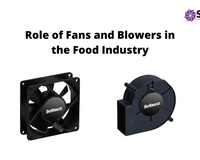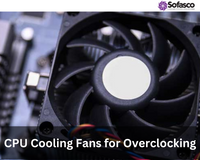Impeller fans are essential components in a wide range of industrial applications, from ventilation and HVAC systems to automotive engines and manufacturing processes. These fans are designed to move air or gases efficiently, ensuring optimal performance in cooling, ventilation and other critical systems. To fully appreciate the importance of impeller fans, it’s vital to understand the key components that make up these fans and how each one contributes to their overall performance. In this article, we will dive deep into the components of impeller fans and how they work together to enhance efficiency, reliability and longevity.
What Are Impeller Fans? And It’s Working Principles
Impeller fans are mechanical devices used to move air or gases through systems. Unlike axial fans, which move air along the axis of the fan, impeller fans (also known as centrifugal fans) use a rotating set of blades or vanes to push air outward. This creates centrifugal force that drives the airflow, making impeller fans ideal for applications that require high air pressure or volume.
The main working principle of an impeller fan is the conversion of rotational motion into dynamic airflow. As the fan blades rotate, air is drawn into the center of the fan, where it is then forced outward through the blades. This creates high-velocity airflow, which is often essential for cooling systems, ventilation in industrial plants, or even exhaust systems in automotive engines.
Key Components of Impeller Fans
Impeller Blades: The impeller blades are the heart of the fan, responsible for generating airflow. These blades come in various designs, including forward-curved, backward-curved and radial blades, each catering to specific applications.
- Forward-Curved Blades: Typically used for applications requiring lower pressure and higher airflow, these blades are ideal for moving air over long distances with minimal energy use. However, they can be less efficient in high-pressure situations.
- Backward-Curved Blades: Designed for high-pressure applications, these blades are more efficient at converting energy into airflow. Backward-curved blades reduce the risk of fan surges and are commonly found in industrial processes where high airflow and pressure are required.
- Radial Blades: These blades offer a balance between high pressure and high airflow and are used in applications that demand robust airflow and pressure control.
Hub: The hub connects the blades to the motor shaft, allowing them to rotate. It also plays a crucial role in maintaining balance during operation. A well-designed hub ensures that the blades remain stable and aligned, reducing the risk of vibration or imbalance, which can lead to premature wear and inefficient operation.
Motor: The motor is responsible for driving the impeller blades, converting electrical energy into mechanical motion. The type of motor used (AC, DC, or brushless) significantly affects the fan’s efficiency and performance.
- AC Motors: Commonly used in industrial and HVAC applications due to their reliability and energy efficiency.
- DC Motors: Often chosen for applications where variable speed control is necessary.
- Brushless Motors: Offer improved energy efficiency and extended lifespan due to the absence of brushes that wear out over time.
Housing/Casing: The casing or housing of an impeller fan plays a key role in protecting internal components while optimizing airflow. It is designed to minimize air resistance and prevent debris from entering the fan, which could cause damage or imbalance. The casing also serves as a barrier to noise, reducing the sound generated by the fan during operation.
Bearings: Bearings are integral to the smooth operation of the fan, allowing the impeller to rotate with minimal friction. High-quality bearings reduce heat generation, which extends the lifespan of the fan. Bearings also play a significant role in reducing noise and vibration during fan operation.
Shaft: The shaft transfers power from the motor to the impeller blades, allowing them to rotate. A precisely engineered shaft ensures smooth operation and prevents misalignment, which can lead to inefficiency, vibration, and wear. The shaft is also responsible for maintaining the balance of the fan during operation, preventing any wobbling or instability.
Mounting Frame/Bracket: The frame or bracket holds the fan securely in place and provides support during operation. It helps reduce vibration and maintains proper alignment, which is crucial for peak performance and longevity. A sturdy mounting system ensures that the fan remains stable and reduces the risk of damage from vibrations or misalignment.
The Role of Components in Enhancing Performance
Each component of an impeller fan is designed to work in harmony with the others to optimize performance. By combining high-quality materials and precision engineering, impeller fans can achieve maximum efficiency, reliability and durability.
- Efficient Airflow: Blade design and the aerodynamic shape of the housing contribute to smooth, high-volume airflow, which is essential for cooling, ventilation, and other applications.
- Energy Efficiency: The motor, bearings and balanced components help reduce energy consumption. This is particularly important in industries that operate large ventilation systems, where energy costs can be a significant portion of the overall operating budget.
- Durability and Reliability: High-quality bearings, precision shafts and rugged casings ensure that impeller fans perform reliably even in harsh industrial environments. This reduces the need for frequent repairs and minimizes downtime.
- Noise Reduction: A well-balanced fan with smooth-moving parts generates less noise, improving the working environment, especially in sensitive areas like medical or telecommunication facilities.
Common Impeller Fan Issues and Their Causes
While impeller fans are designed to be robust, issues can still arise. Common problems include:
- Imbalance: Caused by misaligned blades, damaged bearings, or improper repairs. Imbalance leads to excessive vibration, which can cause premature wear on the motor and bearings.
- Wear and Tear: Over time, components like bearings and blades degrade due to constant use. Material fatigue and corrosion from harsh environments can also affect performance.
- Debris Damage: Foreign objects entering the fan can cause damage to the blades, leading to imbalances and reduced efficiency.
- Improper Maintenance: Lack of regular maintenance, such as cleaning and lubrication, can lead to increased friction, overheating and eventual breakdowns.
How to Resolve Impeller Imbalance Issues?
Once impeller imbalance is detected, resolving it swiftly ensures the continued efficiency of the fan or blower. The following approaches can effectively address these issues:
- Precision Balancing: Impellers can be balanced dynamically or statically using specialized equipment. Dynamic balancing is typically more effective, addressing weight distribution issues while the impeller is in motion.
- Routine Maintenance: A robust maintenance schedule ensures timely cleaning, lubrication, and inspection of impeller fans and blowers. This practice minimizes the risk of imbalance caused by dirt, corrosion, or wear.
- Repair or Replace Damaged Components: If visual inspections or diagnostic tests reveal damage, repairs or replacements may be necessary. Ensure that components such as blades, shafts, and bearings are in good condition and properly aligned.
- Advanced Diagnostic Tools: Employing tools such as laser alignment systems or vibration analyzers can help identify and rectify complex imbalance issues accurately.
- Material Upgrades: If impellers experience frequent imbalance due to corrosion or wear, switching to more durable materials may offer a long-term solution.
- Professional Assistance: For severe cases of impeller imbalance, engaging professional services can ensure the issue is resolved efficiently and effectively.
Impeller fans are essential for efficient air movement in a variety of industrial applications. By understanding the key components that make up an impeller fan, businesses can make informed decisions about the right fan for their needs.
At Sofasco™ International, we offer a wide range of precision-engineered impeller fans tailored to meet the needs of various industrial applications. Our fans are designed to deliver optimal performance, longevity and energy efficiency. Contact us today to learn more about how our impeller fans can enhance your operations and help you achieve your energy and performance goals.












